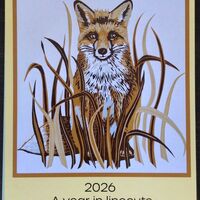About linocut

There are various types of lino available for art purposes, ranging from the traditional, made from linseed oil and cork, to various vinyl and plastic based products. Whichever is used the carving process is essentially similar. The inks used are specialist printing inks which have the properties of staying workable long enough to be rolled out onto the block, and can be oil or water based.
Printing papers typically are very smooth so as to take a good coverage of ink. They can range from very fine -almost see through, to beautifully thick and soft almost like fabric.
Reduction Printing
A reduction print is where a single Lino block is carved “reduced” in stages and the colours are printed in layers from each carved stage. There are advantages and disadvantages to this method. The advantages being that only one block is needed thus reducing materials and also using the same block for each layer /colour means it will exactly line up with what’s gone on before. The disadvantages are that the size of the edition is fixed at the beginning of the process and cannot be added to. This also means that any mistakes made along the way will mean fewer and fewer good prints at the end. Printmakers sometimes allow for this and factor in a percentage wastage when doing reduction prints.
In printing terms, the lining up of the layers is called registration. The multiple layers sit exactly on top of one another and the print makes sense. If the registration is poor, the print will look blurry. I use a very simple method of registration which uses two 90 degree corners fixed on top of each other. Sometimes I like the effect where a print is mis-registered and you can see a sliver of the underneath colour as an accent which adds another dimension to the image. However this effect is usually thought of as undesirable.
Reduction print of 4 colours in stages

Peacock: 1st layer beige ink onto white paper. In this first stage I have carved away any areas that I want to remain white, such as around the eye, the beak, and the feather quills. Beige ink is rolled onto the lino and the paper is laid on top and printed. The carved areas remain white.

Peacock: 2nd layer blue ink over the beige. The lino block is cleaned and carved again. this time I'm carving away any areas that I want to remain beige, then I ink up and print with the blue.

Peacock: 3rd layer green ink over the blue and beige. Now I carve away the areas to be left blue and re-ink with green ink. There are three colours on top of each other and the image is becoming clear.

Peacock: 4th and final layer black ink over the green, blue and beige. Once the areas I want to remain green are carved away, I can ink up with black and the image suddenly has depth and shadows.
When is a print not a print?
If an artist produced an oil painting and was really pleased with it, they might like to have prints made from the image. The painting might sell at say, £500, and the prints (identical copies) at say, £50. These prints are reproductions (also known as art prints, fine art prints or giclee prints) and are identical to the original. If they decide to only ever make 50 of these reproductions, (an edition to 50), the copies would be labelled 1/50, 2/50 etc. (Edition meaning a set that are exactly the same) These may or may not be signed.
Another scenario is that instead of limiting the edition, they might decide that they like the painting so much that they will produce an endless supply of prints from it (open edition). These would not be numbered and not be a limited edition. These may or may not be signed.

My Reduction prints fall into the category of limited edition original prints. It is physically impossible for more prints to be made once the Lino block has been completely carved.
It is also possible to make an open edition of Lino prints but these would not be reduction prints and would often be one colour prints. In reality, a Lino block could not be used indefinitely, as it would start to degrade at some point.
Printmakers don’t usually have fine art reproductions of their work made, as it blurs the distinction between reproduction prints and original prints. This is why the only copies I have made of my work are for greetings cards, where by their nature it is quite clear that they are not and could not be original prints.
































































